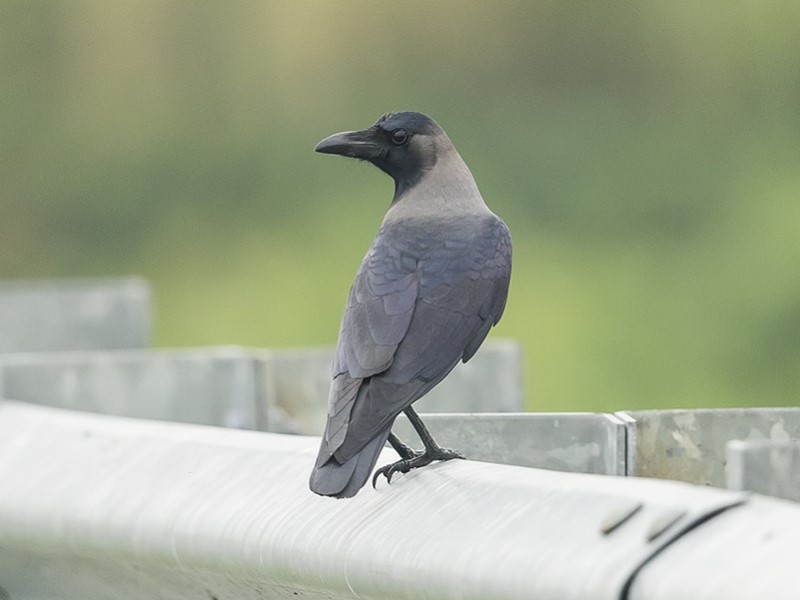House Crow Corvus splendens 家鴉
Category IIB. Alien invasive resident mainly restricted to the urban areas.
IDENTIFICATION

Mar. 2014, KWOK Tsz Ki.
40–43 cm. A relatively small crow with long and slightly arched bill. Black on fore part of the head and throat, a greyish shawl around the nape, hindneck and shoulders and greyish-black from mantle to tail and wings. Bare parts black. Sexes similar.
Juvenile is similar to adult but duller, without gloss on black parts of plumage.
VOCALISATIONS
The call thinner and slightly more nasal than other large black crows in HK.
DISTRIBUTION & HABITAT PREFERENCE
House Crow primarily inhabits urban areas in Kowloon, and sightings away from there are rare. However, there have been records at Stonecutter's Island, Long Valley, Tsim Bei Tsui, Mai Po, Pak Nai, Peng Chau, HK Island (Central and Western District) and Tai O. House Crow is often found near densely populated areas or areas that allow scavenging, such as container ports and wholesale markets.
The breeding atlas showed that its 1km sq occupancy increased from 0.2% in 1993-96 to 0.6% in 2016-19, while in the winter atlas this increased from 0.5% in 2001-05 to 0.7% in 2016-19.
OCCURRENCE
The first record of a House Crow in HK was a single individual in Kowloon Tong in 1974; a second record occurred in 1980. Subsequently, in the period 1986-1997, there were ten more records of up to two birds. This was followed by up to 20 birds in West Kowloon in 2000; this population increased to a maximum of 250 birds. Due to well-documented potential impacts on local breeding birds from this invasive, non-native species, since 2004, the Agriculture, Fisheries, and Conservation Department has conducted control of the local population, resulting in a decline to less than 100 individuals in recent years (AFCD, unpublished data).
House Crow is a resident species that occurs throughout the year. Although sightings appear irruptive and irregular, this is likely an artifact of observer activity. Birdwatching activities in densely populated area are low and irregular.
The largest populations are restricted to urban Kowloon. Although most of the records concern singles or a few birds, large flocks of up to 100 birds have been reported. The highest count is 104 in Sham Shui Po on 29 August 2019, followed by 100 birds at Yau Yat Chuen on 1 December 2002. Populations outside the urban Kowloon are very small, mostly only one or two birds.
BEHAVIOUR, FORAGING & DIET
Large flocks of up to 100 clamorous and sociable birds occur, sometimes forming evening roosts. At Mai Po NR single birds have been seen roosting with Collared Crows. Birds are frequently seen perching on wires or on building tops. Although omnivorous, local data on diet is scarce.
BREEDING
House Crow mainly breeds from March to August, where nests are mostly built on canopies of large trees. Juveniles are mostly seen in June, but sightings of these have become rarer in recent years due to activities of AFCD since 2004. The majority, if not all, of breeding activities are restricted to urban Kowloon, especially Sham Shui Po and Kowloon City.
RANGE & SYSTEMATICS
Five subspecies are recognized across the range from Iran and the Indian subcontinent through Bhutan, Bangladesh, Myanmar, Sri Lanka and the Maldives to Thailand (Madge 2020). Only C. s. insolens occurs in extreme south China (south Tibet and south Yunnan). Introduced around the world (including America, Europe, east Africa, other parts of Asia, Indian Ocean islands and Australia). The taxon occurring in Hong Kong is undetermined.
CONSERVATION STATUS
IUCN: Least Concern. Population trend stable.
House Crow is known to carry a number of human pathogens, including at least eight human enteric diseases (including Salmonella and Escherichia coli) among others (including possibly cholera). The lack of natural predators in places to which it has been introduced means the population grows unchecked, and its unsavoury diet and close proximity to people suggest that human health could be at risk. Control is attempted in HK and various countries (Aden, Kenya, Tanzania and South Africa) by one or more of trapping, poisoning and destroying nests.
Madge, S. (2020). House Crow (Corvus splendens), version 1.0. In Birds of the World (J. del Hoyo, A. Elliott, J. Sargatal, D. A. Christie, and E. de Juana, Editors). Cornell Lab of Ornithology, Ithaca, NY, USA. https://doi.org/10.2173/bow.houcro1.01

